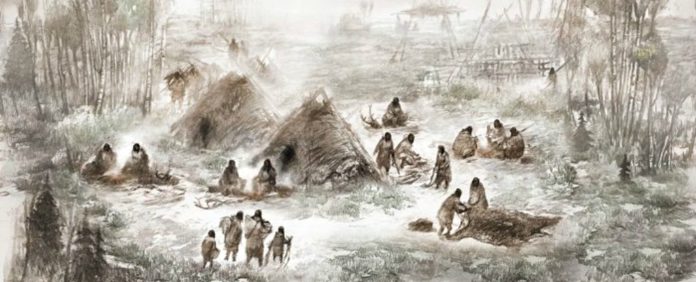
A new discovery has been made about the origins of Native American society, potentially turning past theories on their heads.
Ancient DNA discovered has revealed a population of Native Americans, which explains how ancient populations inhabited the Americas. Anthropologist Ben Potter, from the University of Alaska Fairbanks, explained that DNA of those once thought of as the first original American settlers, migrating via the Bering Land Bridge, do not match up to the latest DNA findings of a 6-week old girl’s ancient remains, found in 2013.
The findings, published in Nature on January 3, 2018, detail a forgotten people called the Ancient Beringians. The genetic analysis of the 11,500 year-old remains of sunrise girl-child (“Xach’itee’aanenh T’eede Gaay”) were sequenced, and what the researchers found astounded them.
Found in Alaska, sunrise girl-child, and another ancient infant, known as dawn twilight girl-child (“Yełkaanenh T’eede Gaay”), were found by Potter and his colleagues at Upward Sun River at an Interior Alaska archaeological site.
What has always remained a topic for debate, to this day, is how the first American settlers crossed into Alaska via the Bering Land Bridge, a landmass that once connected Asia and North America. The difficult journey would have followed a harsh route between Siberia and Alaska; however, many scientists have contested several theories on how this frosty corridor, which would have been blocked by glaciers, was ever passed.

What was agreed upon up until now, is the existence of two recognised branches of early Native American settlers, more commonly known as the Northern and Southern branches. When sunrise girl-child’s DNA was sequenced, Potter explains the Ancient Beringians most likely split from the East Asian group around 35,000 years ago, and then at some point, migrated into North America.
From there, the population split again, with one of the groups belonging to the Ancient Beringians and the other group forming the basis of all other Native Americans, who then travelled south over the ice sheets some 15,700 years ago.
According to Cambridge University evolutionary geneticist Eske Willerslev, this finding provides evidence of all Native Americans being traced back to a single source of population, and from a single migration event.
The two ancient children discovered, sunrise girl-child and dawn twilight girl-child, are thought to have been first cousins. It is now believed they were born in the Late Pleistocene period in the Alaskan wilderness.
At the time, the North American ice cap extended down to the Great Lakes resting between Canada and the United States. Common theory is that during the Pleistocene Epoch, most of the human species died out, with those left surviving then migrating across continents during the Late Pleistocene Age.
The Ancient Beringian population is thought to have lasted thousands of years before being absorbed by the Athabascan ancestors, a Native American population who ventured north around 6,000 years ago. From this point, strong cultural roots to the land were established.
This new information reveals a more accurate picture of Native American ancestry, and how America came to be inhabited by ancient populations in the New World.
“There is very limited genetic information about modern Alaska Athabascan people,” Potter said. “These findings create opportunities for Alaska Native people to gain new knowledge about their own connections to both the northern Native American and Ancient Beringian people.”





Wow that’s amazing, something new about my heritage. This is something I am gonna have to look more into.
Let’s just forget about the Clovis people that were here before ‘native’ americans.